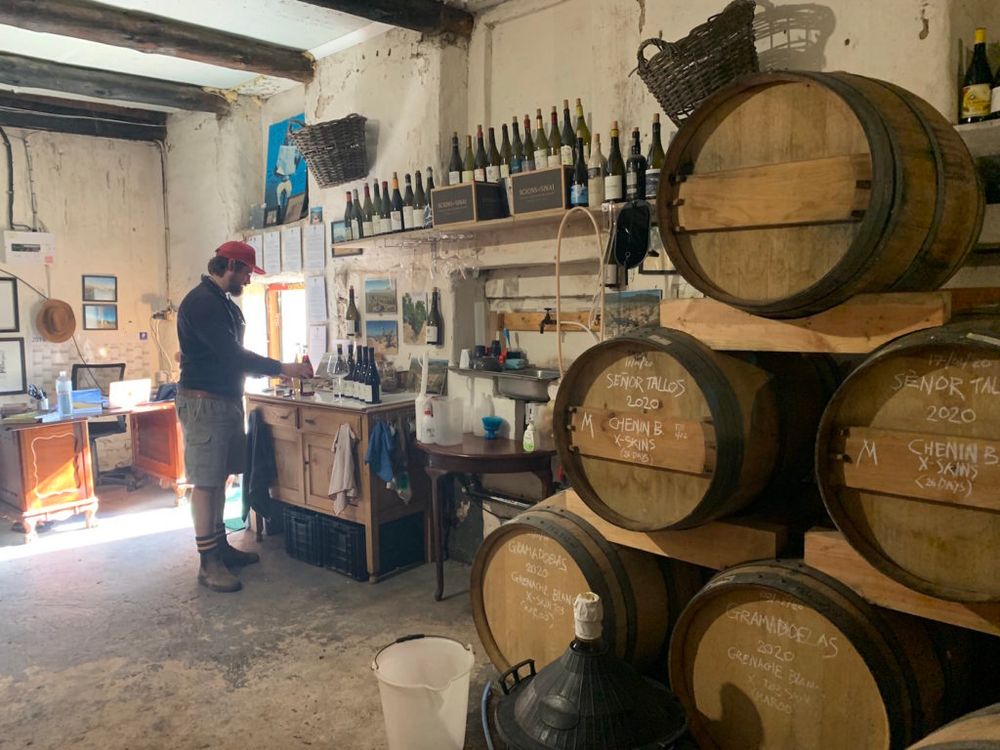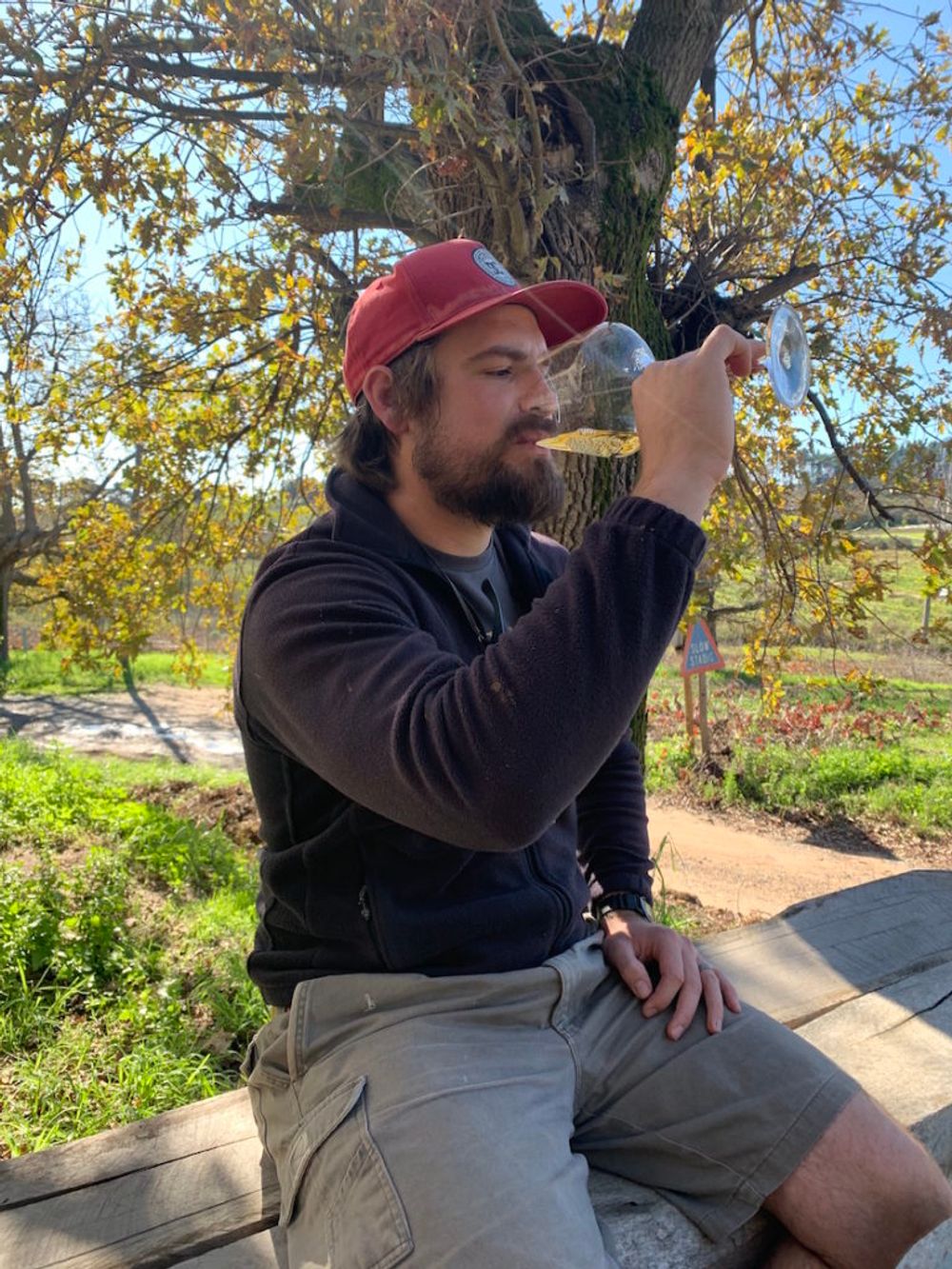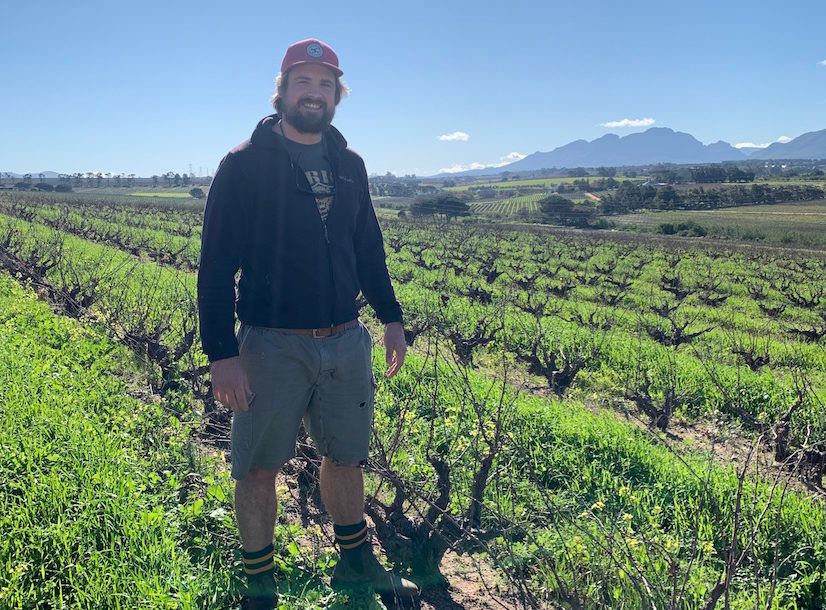Lambert tastes the entire Scions of Sinai range including new additions: a 100% Grenache Blanc called Gramadoelas and a 100% Cinsaut called Heldervallei.
Bernhard Bredell’s roots are dug deep into Sinai Hill. In the1970s his grandfather planted the vines he now tends, across a few locations in Stellenbosch’s Lower Helderberg — an important distinction, South Africa’s most famous wine region is stitched together with a number of different wards, all experiencing their own climatic conditions. Here, on granite outcrop Sinai Hill we’re the closest to the ocean, a fact illustrated by the salty whip of a sea breeze as we walk along a row of Chenin bushvines, their trunks thick and twisted by time.

The Bredell family have been wine farmers for over 160 years. The Scions of Sinai project was born as a way for Bernhard to preserve some of the old vineyards his grandfather planted. The name reflects this commitment to both land and family: a ‘scion’ being both the upper part of the vine or a young shoot as well as a generational descendant.
Though he now rents the sites, he is still responsible for the organic minded approaches in viticulture (he’s obsessed with soil and has the degree to prove it) as well as the vinification, which takes place in a small cellar overlooking the Helderberg Mountains.

Bernhard Bredell, July 2020
It felt important to see the vineyards before tasting their produce; for Bredell his wines are about both the preservation of the past as well as ensuring future generations have access to working with ‘the special stuff’, namely his young son Noah, now an 8thgeneration scion.
“We don’t own these vineyards, we’re borrowing them from the next generation.”
Back at his cellar, we carry bottles of the 2019s and paper-thin glasses out into the winter sunshine. A simple wooden bench and a lopsided table make for the perfect viewpoint from which to enjoy the vista of the Helderberg Mountain beyond, its slopes variegated in shades of purple and blue.

Bredell: obsessed with soil
Bredell works minimally and hyper hygienically in the cellar. “It’s a small space and I’m largely on my own, so I have control over what’s happening.”
The wines all spontaneously ferment in open-top fermenters, free run juice or an old basket press is used. Only older oak barrels are used for maturation of varying sizes for varying times. Whites all enjoy some skin maceration. The wines are bottled unfiltered and unfined.
“I’m not trying to be weird or funky – for me what’s most important is to have that line between vineyard and glass as uncompromised as possible,” he shares.

The first in the line-up The Granietsteen (granite rock) Chenin Blanc 2019 is from 42 year old vines vines that walks the line of its Lower Helderberg origin; granite tension and tight steely acid reeled in by ocean breezes. Clean, pure tropical flavours like green pineapple and just-ripe mango with a salty lick on the finish.
With the next wine we leave the Helderberg for a new addition to the range, the Gramadoelas 2019. ‘Gramadoelas’ is a colloquial Afrikaans word for ‘the middle of nowhere’. And that’s just where this wine hails from. 100% Grenache Blanc planted in 2009, inbetween schist and shale hills in South Africa’s most easterly viticultural region, on the edge of the Klein Karoo.
“The vineyard reminds me of a typical setting you’d find in Spain’s Priorat region,” elaborates Bredell.
There’s a family connection, of course, his father (once the Bredell’s winemaker) lives out there and farms cattle. The family has been visiting the Karoo since they were kids, ‘while others were out learning to surf, we were spelunking in bushman caves.’
The Gramadoelas is textured and tangy. At a refreshing 12% ABV, some lees contact adds weight, and buoys up punchy citrus and ripe pear flavours, a savoury herbaceous finish plays nicely along a line of sherbety acidity.
Also new in the portfolio is the Heldervallei 2019. 100% Cinsaut from a single vineyard planted in 1988 in the Lower Helderberg. The first most obvious thing about the wine is its intense perfume; rose petals, winter lilies and something edgier, like the tang of blood.
“You always get this incredible fragrance from the combination of silica and iron ferricrete soils of the vineyard,” says Bredell.
Fresh cherries, cranberries and a touch of white pepper sail along with the flora on the palate – it’s not just pretty though, the fruit, though bright, is concentrated and tight, like a singularity about to burst.
The perfect follow-on from this is the Féniks 2019. It’s a new-wave style Pinotage, focusing on the fresher expression of the grape. The bushvines were planted in 1976 by Bredell’s grandfather and great uncle, and is located just 3.5km from the ocean, the closest such registered vineyard in South Africa. Other than its maritime macro-climate, another unusual thing for a Pinotage vineyard is its soils – well drained, sandy, silica-rich granite, whereas Pinotage is usually planted on clay mountain slopes or more fertile soil types.
In the vinification Bredell kept 70% of the stems intact with the grapes. There’s a gentleness to this wine; like a shaded walk in a forest. Berries and bramble leaf aromas lift slightly over the scent of earth after the rain, the palate is lean and refreshing, carrying those berries, but with a spine of river pebbles tailing out to a mineral finish.
The last wine is the one that’s gotten Bernhard the most attention. The Swanesang 2019 is made from the last standing bushvines of Syrah in the Helderberg district; it’s also the closest Syrah vineyard in Stellenbosch to the ocean.
The utter vibrancy and energy of this wine. A pure, almost raw expression of Syrah with top notes of blackberries, dark cherries, violets, black olive and white pepper spice. On the palate 40% whole-clusters add a lifted layer of freshness, powdery tannins, and a delicate structure all add to its undeniable elegance.
Bernhard’s commitment to producing wines that reflect the vineyards his family planted and his mission to preserve his Lower Helderbeg heritage has resulted in a portfolio of wines that are focused, precise and because of this care each wine tells its fascinating story of origin with total clarity.

Malu Lambert won the title of the Mont Blanc Emerging Wine Writer of the Year at the Louis Roederer International Wine Writers’ Awards 2019. She also won the Veritas Young Wine Writer in 2015. She writes for numerous South African titles, and is the wine editor of Food & Home. Internationally, she has also written for Jancis Robinson, The Buyer & Decanter. Notably, she has just been inducted as a taster on Platter’s by Diners Club South African Wine Guide, South Africa’s most definitive and respected guide to wine. Malu is also currently a WSET Diploma student and loves nothing more than to geek-out about wine. She sits on various judging panels and is a graduate of the Michael Fridjhon Wine Judging Academy. The rest of the time she runs, FABLE: a story-telling, social media and copywriting company. And, occasionally, helps out her husband in their craft spirits’ distillery on the Cape Peninsula. www.malulambert.com, follow her on @malulambert










































